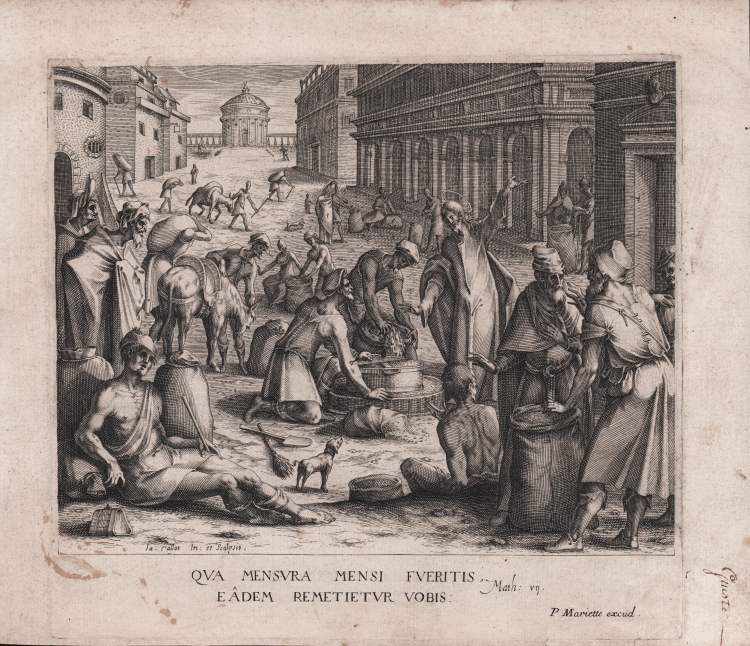




| Reference: | S45169 |
| Author | Jacques CALLOT |
| Year: | 1609 ca. |
| Measures: | 210 x 195 mm |



| Reference: | S45169 |
| Author | Jacques CALLOT |
| Year: | 1609 ca. |
| Measures: | 210 x 195 mm |
Street in a classical setting, with Christ standing next to the grain weighters, his arm raised; in the foreground, on the right, two men standing next to a bag; on the left a seated man leaning on bags; in the distance, at the end of the street, a rotunda.
Engraving, circa 1609/11, lettered with production detail: 'Ia: Callot In. et Sculpsit', and quotation in Latin from the Bible (Matt. 7): Qua Mensura Mensi Fueritis Eadem Remetietur Vobis [The same will be returned to you according to the measure of the month you have taken].
Example of the second state with Mariette imprint at lower right.
A fine impression on contemporary laid paper, with margins, small spots at the bottom left, otherwise good condition.
Rare.
Bibliografia
Meaume 1860, Recherches sur la vie et les ouvrages de Jacques Callot (52); Lieure 1927, Jacques Callot (50); 'Jacques Callot' (Nancy 1992) No.19.
Jacques CALLOT (Nancy 1592 - 1635)
|
He was a baroque graphics artist, draftsman and printmaker from the Duchy of Lorraine (an independant state on the North-Eastern border with France). He made etchings that chronicled the people and the life of his period (soldiers, clowns, drunkards, wanderers, beggars, and various outcasts). These images of people are often contrasted by spectacular landscapes (see, for instance, "The Temptation of St. Anthony"). His skill in shading and his use of different tones were remarkable for the period and he is often compared to Albrecht Dürer.
|
Jacques CALLOT (Nancy 1592 - 1635)
|
He was a baroque graphics artist, draftsman and printmaker from the Duchy of Lorraine (an independant state on the North-Eastern border with France). He made etchings that chronicled the people and the life of his period (soldiers, clowns, drunkards, wanderers, beggars, and various outcasts). These images of people are often contrasted by spectacular landscapes (see, for instance, "The Temptation of St. Anthony"). His skill in shading and his use of different tones were remarkable for the period and he is often compared to Albrecht Dürer.
|